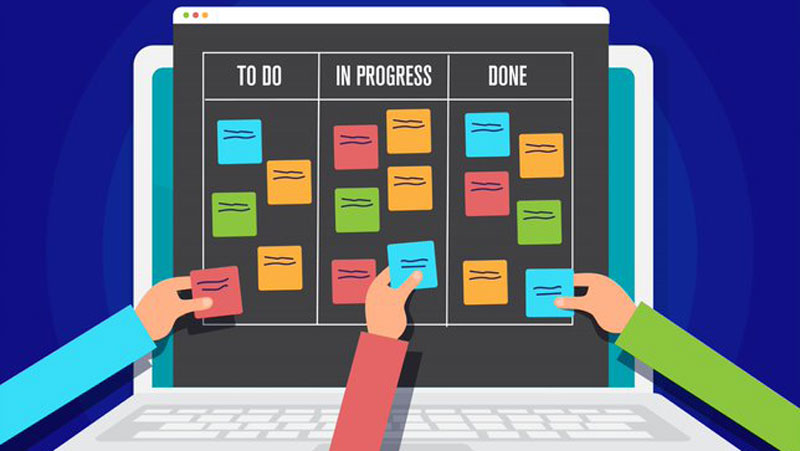 Can visualizing your work really make that big of a difference in your productivity? The science of Kanban visualization points to yes.
Can visualizing your work really make that big of a difference in your productivity? The science of Kanban visualization points to yes.
What is visualization?
If you’re trying to be more productive, intentional, or efficient in your work or personal life, you’ve probably heard about visualization. Visualization is a term that simply describes the process of making something visual. We usually use it to describe visualizing your work, by which we mean using visual cues to manage your workflow (such as in Kanban), as opposed to written to-do lists.
Visualization can also describe the mindfulness practice of defining an objective, and bringing it to reality by “visualizing” it into existence.
Olympic athletes, Formula 1 drivers, and NBA players all use the power of visualization to mentally prepare themselves for achieving greatness.
Although this might sound a little fluffy, it’s backed by science. For athletes, science has shown that visualizing practicing a movement is as effective as actually practicing it. This is because visualization and action are intimately connected, involving the motor cortex. Thinking about our body doing something—raising an arm or walking forward—activates the motor cortex directly.
Kanban is a workflow management method that combines the benefits of visualizing your work (managing your work in a visual way), with the power of mindfulness (creating new realities by visualizing them inside your mind). Looking into the science of Kanban visualization helps to explain how mastering your workflow is really about mastering your mindset.
5 ways to-do lists limit productivity
For many people, creating a to-do list is an action almost synonymous with productivity. While jotting down what needs to be done peut be a useful way to clarify our own tasks, to-do lists can be incredibly limiting when we try to scale them to the team or organizational level.
Let’s discuss why this frequently used approach can actually get in the way of our productivity.
Text vs. visual information
We are visual creatures, born and bred to process visual information. Reading text is a relatively new development, evolutionarily speaking. The purpose of any work organization aid (like a to-do list, or a Tableau Kanban) is to help us get more done.
But processing a lot of text at once is cognitively exhausting.
That’s why, when we’re in school, we often incorporate visual methods to help us learn what’s in our textbooks: We use graphs, charts, color-coded systems, and flash cards. This helps us see and recognize what’s important quickly.
Similarly, visual work management methods like Kanban help our eyes gravitate naturally to what’s most important. If an item is on your written to-do list and the due date is looming, you have to keep track of that information. If it’s on your online Kanban board, it’ll keep track of the deadline for you — changing color from white to yellow, and eventually to red, to signal an approaching due date or overdue task.
Not prioritized
To-do lists tend to operate as a sort of snapshot in time — you jot down whatever tasks are top of mind, and then start tackling them one by one.
To-do lists usually aren’t a true reflection of what we actually really need to be working on on a specific day.
They’re more of a reflection of what seems most important or urgent. But when you use Kanban visualization to organize your tasks, you can see what you actually need to be working on, and re-prioritize work as needed. You can accept new requests (or not) in the context of your other work.
No beginning, no end
With to-do lists, it’s very easy to let our workload get unwieldy. You can add and add and add tasks to the end of the to-do list to your heart’s (dis)content. The problem with this is, the more you have in progress, the more energy and cognitive space you’re having to devote to just keeping track of that work — meaning, the more you add to your list, the slower you’ll be able to deliver the tasks on it.
Visual work management methods (like Kanban) often include ways to actively (and proactively) manage your individual and team capacity, helping you keep your workload reasonable so you can keep it moving to “Done.” Learn more about managing your workload in our article, Why We Need WIP Limits.
Not synced
While there are some cloud-based, to-do list-type apps designed for teams, most people who use to-do lists day to day store them on a piece of paper, or on a notes app on their phone or computer.
The problem with this is that these to-do lists don’t magically sync up with your coworkers’ lists. They may not even sync up with the other software you might be using to manage your work.
Unless you diligently groom your to-do list to keep it organized by priority and due date, your lists probably go “stale” (become inaccurate) quickly.
It’s likely that you start each day with a fresh to-do list, meaning that it’s up to you to decide what goes on that list — without any context or record of any decisions previously made to prioritize one piece of work over another.
Not collaborative
To-do lists, at the individual level, don’t inherently provide you with a way to communicate status, priority, or urgency — all essential bits of information required for collaboration. Even cloud-based to-do list tools that are designed for teams aren’t necessarily great for high-level collaboration.
Imagine, for example, that you have five tasks on your team’s list that are all equally important and urgent. There are also other tasks on your team’s list of varying degrees of importance and urgency. The tool you’re using only displays the name of the task, a due date, and who the task is assigned to at the list level. How do you communicate with your team about what tasks to do first? What does the team have to do to gather the information they need to prioritize these tasks?
Avec un Kanban tool, you can use visual cues to communicate information such as priority and urgency.
You can build your board to organize and order work items in a way that everyone understands. You can visualize process steps so that everyone understands, at a glance, exactly where each task is in your process. You can “block” cards or move them backwards in the process if other, more pressing work needs to take higher priority.
Visualize a more productive future
Harnessing the power of visualization with Kanban can help your team get more done every day, by making the information you need easier to find, understand, and communicate.
Learn more about how to use the science of Kanban visualization to boost your team’s productivity in our latest ebook, Kanban 101: Supercharge your team’s productivity with visual project management.




